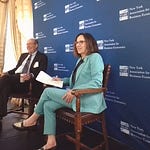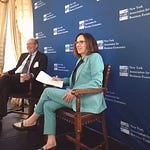Ryan Sweet is the first to note that the jump in January consumer prices was hotter than both the consensus and he himself had expected: the headline CPI jumped 0.5% and the core rate that takes out food and energy was up 0.3%, both the biggest moves since May of last year.
But unlike many traders and investors, the chief U.S. economist at Oxford Economics was not exactly caught off guard. He had already adjusted his forecast for the Fed’s policy path this year from three 1/4 point cuts to just one 25bps reduction in December. And he has no doubt today’s CPI numbers back up that view.
”I don't think this is the new normal (that) we're going to see the 0.5% increase in the CPI in the next several months, but it is going to give the Fed plenty of reason to pause,” Ryan says.
”And I think (the Fed is) going to feel most comfortable, given all the uncertainty around tariffs staying on the sidelines for the foreseeable future.”
So dive in and hear, see what Ryan has to say and why he forecasts that a Fed Rate cut in the final month of the year it will be followed by more as 2026 gets underway. Why he sees housing inflation here to stay for the foreseeable future, and why tariffs could boost lumber prices and slow down the pace of construction so badly needed now. And much more.
January CPI was more than just eggs 00:01:27:01 - 00:02:15:18
It wasn't all eggs. (Kathleen: I kind of wish it was all eggs. I love eggs, by the way. And they're too expensive.) I'm a big fan of eggs, but I thought it was pretty broad based. And we saw price increases of 37 <categories> across services. Now, look, services is very sensitive, sort of surprising based on what's going on the labor market and seeing the market improve a little bit over the last several months. Overall, the job market is still fairly strong… putting a little bit upward pressure on inflation.
Seasonal Adjustment is imperfect even when we expect increases 00:02:15:20 - 00:02:41:01
January was plagued by a lot of parts of the so-called residual seasonality. These businesses being generally raise their prices earlier in the year, and that's just not being able to accurately capture by seasonal adjustments. So I don't think this is the new normal we're going to see the 0.5% increase in the CPI in the next several months, but it is going to give the Fed plenty of reason to pause.
Tariffs to keep Fed on sidelines 00:02:41:01 - 00:02:48:10
And I think we're going to feel most comfortable, given all the uncertainty around tariffs staying on the sidelines for the foreseeable future.
Forecast re-set is not an overreaction- 00:03:19:23 - 00:03:29:01
I don't think it's an overreaction because the job market (strength) continues and (they’re) not worrying too much about the fulfillment side of demand.
Inflation and Tariffs haunt the Fed 00:03:29:02 - 00:04:22:19
<Inflation> is proving to be a thorn in the Fed's side and given tariffs in all the uncertainty around how aggressive President Trump's going to be on the tariff front. In general, we have a lot of uncertainty around any segment of the outlook for either the labor market or inflation… We're going to want to see how this plays out before they adjust monetary policy, because we can adjust our forecast. And I think it would be great to be wrong, but the Fed can’t get this wrong, and they don't want to overreact and jump the gun by easing into tariffs or hiking into tariffs. They're going to want to see how this plays out on both the inflation front and on the growth side of things as well.
Trump will be measured/ One Fed Rate Cut 00:04:38:08 - 00:05:24:07
Not going to be aggressive. I think given that it's pretty clear that President Trump will follow through with tariffs. No, it's not a matter of if it's when. Very soon. Some tariffs are already implemented. We're still in the camp that the <big> tariffs numbers being thrown out there are unlikely… For example, 25%, possibly some. But, you know, it is an unlikely scenario…. the potential for a little bit of upward pressure on inflation because of these tariffs. So our current baseline is just one 25 basis point rate cut in December.
More aggressive Fed in 2026 00:05:24:07 - 00:05:46:19
But then when the calendar switches to 2026, what's going to shift their attention away from inflation? Because again, tariffs… are one-time increase in the price level that's going to start working its way through. And that opens the door for <the Fed> be more aggressive in cutting interest rates next year.
00:06:41:19 - - 00:07:35:02
Tariffs are complicated. But the impact on inflation isn't necessarily 1 to 1. So Trump's tariffs on China, for example, those prices aren't going to go up 10% because there are a lot of offsets. That is generally going to appreciate the substitution effect. So consumers are going to shift away. For example, made in China, <shifted to> Vietnam, an area that has a lot of lower tariffs.
Business will absorb some of the tariff impact 00:07:35:04 - 00:07:56:09
And in businesses, I think this is potentially the biggest wildcard. You would assume that businesses are going to have to absorb some of the tariff, impact their profit margins because the U.S. consumer, we're very price sensitive and we've gone through an inflation shock since the pandemic and try to push more price increases in consumer. They're going to start pushing back.
Uncertainties and pricing strategies 00:07:56:11 - 00:08:23:15
From the business perspective, given the uncertainty around tariffs, do you want to start setting a precedent now that you to eat some of that additional cost or you try to pass through as much as you can now? There are a lot of moving parts, and that's why I think the inflation outlook - you can see it in the Fed's forecast and the dispersion of forecast among <participants> at this point - because it's unclear when and how aggressive Trump may be with these tariffs.
Markets are not over-reacting to inflation risk 00:09:19:24 - 00:09:43:15
Longer term inflation expectations from market-based bonds are still relatively anchored right around what we want them to be. So that's kind of getting back to our discussion about markets viewing tariffs as a one-time shift in the price level. That's probably the right way to think about it.
Consumers care about prices not inflation 00:09:43:17 - 00:10:18:15
But from the consumer's perspective, they think of price levels. They know … gasoline prices down to the penny. They're not looking at the inflation rate, it's the home price level. So that's one reason why embedded in our forecast is that these tariffs look phased in over-time. So, of course, we (are)… pursuing it because <Trump> campaigned on the idea of bringing down prices…<with> overly aggressively tariffs, the price level will go up. And that's not going to sit
The wrong tariffs could wrong-foot housing supply 00:10:56:11 - 00:12:07:00
But even when you map all the components of the CPI it's still not going to look great in January, there are issues on the CPI but on housing as well. And the solution for that is to build more homes, more apartments. And if you look at the pipeline, I'm looking at the number of single family and multifamily units that are authorized but not started. That's still pretty warm. So we have a lot of construction coming down the pipeline. But something that could upset the apple cart is two things: interest rates and tariffs. But the Trump administration policy puts tariffs on Canada and Mexico. We import a lot of building materials, not just lumber, and … more generally building materials. So if there's one way to kind of delay any additional housing supply, which we desperately need, about 3 million homes, is to put tariffs on building materials, which would really cause a lot of pain amongst small regional homebuilders.
The Fed’s ongoing inflation overshoot 00:12:07:14 - 00:13:28:07
Now, it's very important for investors in the bond market that the Fed's credibility remains intact because the Fed's biggest tool in fighting future inflation is their credibility as an inflation fighter. But you've got to tip your hat to the Fed for essentially a soft landing and (they are) very reluctant to ever (let inflation) get carried back. Now it's possible to get started. <Inflation> is not where they want it to be, but the US just recovered and (they) didn't push the economy into recession.
The Fed must eventually hit the target 00:13:28:09 - 00:13:53:15
Now, if this continues for several more years or doesn't get back to that last mile, we never really finished the race <back to 2%>, then their credibility would likely come into question.
Global impact of Trumps policies 00:14:24:12 - 00:15:34:16
There will be knock on effects and impact form Trump policies. European economies essentially stuck with the European Central Bank. They got a much more difficult road ahead going forward. And then again, with all the uncertainty around tariffs in the world, knock on effects on Europe, on Central Bank of Canada, leading economy. We know Trump follows through with tariffs on Canada. That's going to most likely push the… economy into recession. <The Fed> can kind of sit on the gains for the foreseeable future and see how this plays out. So being on the sidelines and essentially an uneventful year for the Federal Reserve may be exactly what we want, given all the uncertainty around the inflation outlook in terms.
This year’s main Trump policy impact is tariffs 00:16:07:02 - 00:16:26:12
For this year, it's definitely tariffs. And again, from a macro economic perspective, it's going to move the needle, maybe not as much as reports <fear
Global aging and immigration 00:16:26:14 - 00:17:27:23
Immigration is also a big question mark, but immigration can move the needle over time. Less immigration is definitely corrosive on the economy. So each passing year, about the US doing fewer immigrants, fewer born in the country, our labor force is going to continue to soften because we have a demographic issue. It's not as bad as what's going on in Europe or Asia, but our aging population continues to put downward pressure on the labor force and offset some of that drive with the big wave of immigration.
DOGE success faces complications adverse incentives 00:18:26:10 - 00:19:01:20
But we do we do have in our forecast, we see that we're going to find out about $200 billion from government spending, which is a sizable amount. But whether or not that kind of goes to Congress in regards to our the personal life of Congress, I'd rather not be involved in the spending cuts is still up for debate because as an economist, I still believe incentives matter and if officials in the House and the Senate and Senate reelected, they're not going to want to do big spending cuts that undermines their constituents.
Productivity’s run is key to the outlook 00:20:14:05 - 00:20:35:05
I think it's going to be another good year for the challenges ahead, but I think it's long as the supply side of the economy hangs in there. And I think you're watching for this year, but for the next 5 to 10 years and crossing my fingers that productivity growth isn't a flash. So that's one thing maybe I want to happen.
Ryan Sweet
Chief US Economist
New York, United States
Ryan Sweet is the Chief US Economist at Oxford Economics. He is responsible for forecasting and assessing the US macroeconomic outlook and how it will influence monetary policy and financial markets. Ryan is among the most accurate high-frequency forecasters of the U.S. economy, according to MarketWatch and Bloomberg LP.
Prior to joining Oxford Economics, Ryan led real-time economics at Moody's Analytics and was a member of the U.S. macroeconomics team. He was also head of the firm’s monetary policy research, following actions by the Federal Reserve and examining its potential impact on the U.S. economy.
Ryan is an adjunct professor in the Economics and Finance Department at West Chester University of Pennsylvania. He received a master’s degree in finance from John’s Hopkins University, a master's degree in economics from the University of Delaware, and a bachelor's degree in economics from Washington College.














Share this post